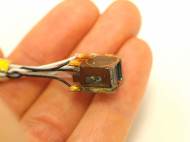NIST mini-sensor measures magnetic activity in human brain
 National Institute of Standards and Technology (NIST) developed a miniature atom-based magnetic sensor that is capable to measure human brain activity at slightly less sensitivity compared to the “gold standard” for such experiments. On the other hand, it does have better portability and it costs less, and it could be used for biomedical applications such as studying mental processes and advancing the understanding of neurological diseases.
National Institute of Standards and Technology (NIST) developed a miniature atom-based magnetic sensor that is capable to measure human brain activity at slightly less sensitivity compared to the “gold standard” for such experiments. On the other hand, it does have better portability and it costs less, and it could be used for biomedical applications such as studying mental processes and advancing the understanding of neurological diseases.
The mini-sensor consists of a container of about 100 billion rubidium atoms in a gas, a low-power infrared laser and fiber optics for detecting the light signals that register magnetic field strength—the atoms absorb more light as the magnetic field increases. NIST and German scientists used the NIST sensor to measure alpha waves in the brain associated with a person opening and closing their eyes as well as signals resulting from stimulation of the hand.
The brain experiments were carried out in a magnetically shielded facility at the Physikalisch Technische Bundesanstalt (PTB) in Berlin, Germany, which has an ongoing program in bio-magnetic imaging using human subjects. The NIST sensor measured magnetic signals of about 1 pT (a trillionth part of a Tesla).
The measurements were verified by comparison with results recorded by the world’s most sensitive commercially available magnetometers – superconducting quantum interference devices (SQUIDs). Unlike SQUID arrays which require special conditions during their use, the NIST sensor is about the size of a sugar cube and operates at room temperature, so it might enable development of new lightweight and flexible magnetoencephalography (MEG) helmets.
MEG devices provide a noninvasive way to measures the magnetic fields produced by electrical activity in the brain, and they are currently used for basic research on perceptual and cognitive processes in healthy subjects, screening of visual perception in newborns, and mapping brain activity prior to surgery to remove tumors or treat epilepsy.
“We’re focusing on making the sensors small, getting them close to the signal source, and making them manufacturable and ultimately low in cost”, said Svenja Knappe, member of the NIST Atomic Devices and Instrumentation Group. “By making an inexpensive system you could have one in every hospital to test for traumatic brain injuries and one for every football team.”
NIST scientists expect they’ll be able to boost the mini-sensor’s performance about tenfold by increasing the amount of detected light, and their calculations predict that such enhanced sensor could match the sensitivity of SQUIDS. NIST scientists are also working on a preliminary multi-sensor magnetic imaging system that could eventually be used in clinically relevant applications.
For more information, read the paper published in the journal Biomedical Optics Express: “Magnetoencephalography with a chip-scale atomic magnetometer”.









Leave your response!